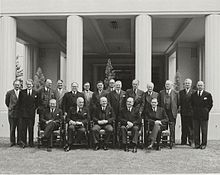- Menzies Government (1949–1966)
-
The Right Honourable
Sir Robert Menzies
KT, AK, CH, FAA, FRS, QC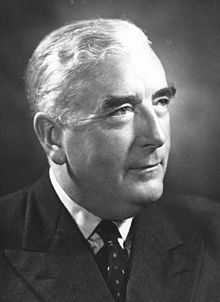
12th Prime Minister of Australia
Elections: 1949, 1951, 1954, 1955, 1958, 1961, 1963In office
19 December 1949 – 26 January 1966Monarch George VI
Elizabeth IIGovernor General William McKell
William Slim
William Morrison
William Sidney
Richard CaseyPreceded by Ben Chifley Succeeded by Harold Holt Personal details Political party Liberal The Menzies Government was the federal Executive Government of Australia led by Prime Minister Robert Menzies. It was made up of members of a Liberal Party of Australia-Country Party of Australia coalition in the Australian Parliament from 1949–1966. Menzies led the Liberal-Country Coalition to election victories in 1949, 1951, 1954, 1955, 1958, 1961 and 1963. Robert Menzies was Australia's longest serving Prime Minister. Robert Menzies had served a previous term as Prime Minister as leader of the United Australia Party from 1939–1941 (see Menzies Government (1939–1941)).
Contents
Background
United Australia Party
The United Australia Party had been formed as a new conservative alliance in 1931, with Labor defector Joseph Lyons as its leader and John Latham, hitherto leader of the Nationalist Party of Australia as his deputy. The stance of Lyons and another former Labor minister, James Fenton, against the more radical proposals of the Labor movement to deal the Great Depression had attracted the support of prominent Australian conservatives. In March 1931, though still a member of the ALP, Lyons supported a no confidence motion against the Scullin Labor government and the UAP was formed from a coalition of citizens’ groups and with the support of the Nationalist Party.[1] In November 1931, Lang Labor dissidents chose to challenge the Scullin Labor government and align with the UAP to pass a ‘no confidence’ and the government fell.
With Australia still suffering the effects of the Great Depression, the newly formed United Australia Party won a landslide victory at the 19 December 1931 Election, and the UAP commenced its first term in government in January 1932.[2] The Lyons Government won three consecutive elections, pursuing a conservative fiscal policy of balanced budgets and debt reduction, while stewarding Australia out of the Depresssion.
Lyons death in 1930 saw Robert Menzies assume the Prime Ministership on the eve of World War II. After a decade in office, the party had declined in popularity, and faced the demands of war in a shaky coalition with the Country Party. Forced to rely on the support of independents following the 1940 election, Menzies resigned in 1941, whereupon the UAP was unable to replace him with a suitable leader and allowed the leader of the junior coalition party, Arthur Fadden to take office. The Fadden Government lasted just 40 days, before the independents crossed the floor bringing Labor's John Curtin to the Prime Ministership just prior to the outbreak of the Pacific War.
Labor's John Curtin proved a popular war time leader and the Curtin Government won in a landslide in the 1943 election. In the aftermath of this defeat, the UAP began to disintegrate, and Australian conservatives and anti-socialist liberals looked to form a new political movement to counter the Australian Labor Party.
Foundation of Liberal Party
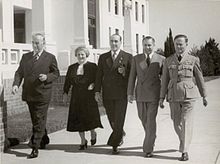 Sir Robert Menzies, Dame Enid Lyons (the first woman member of an Australian Cabinet), Sir Eric Harrison, Harold Holt (Menzies' successor) and an Airforceman in 1946.
Sir Robert Menzies, Dame Enid Lyons (the first woman member of an Australian Cabinet), Sir Eric Harrison, Harold Holt (Menzies' successor) and an Airforceman in 1946.
Fourteen political parties had allied to form the United Australia Party, but disenchantment with the United Australia Party was now wide-spread. A group of New South Wales members had formed the new "Democratic Party". This new group looked to Robert Menzies to provide leadership.[3] Menzies called a conference of conservative parties and other groups opposed to the ruling Australian Labor Party which met in Canberra on 13 October 1944, and again in Albury in December 1944.[4][5] The formation of the party was formally announced at Sydney Town Hall on 31 August 1945.[5]
Menzies had served as Prime Minister as leader of the United Australia Party from 1939–1941.[6] From 1942 onward, Menzies had maintained his public profile with his series of “Forgotten People” radio talks, similar to U.S. President Franklin D. Roosevelt’s “fireside chats” of the 1930s, in which he spoke of the middle class as the "backbone of Australia" but as nevertheless having been "taken for granted" by political parties and of being effectively powerless because of lack of wealth on the one hand, and lack of organization on the other.[7][8]
Outlining his vision for a new political movement in 1944, Menzies said:
“ "...[W]hat we must look for, and it is a matter of desperate importance to our society, is a true revival of liberal thought which will work for social justice and security, for national power and national progress, and for the full development of the individual citizen, though not through the dull and deadening process of socialism.[9] ” Menzies wanted the new party to be independent of interest groups like big business and so sought to organise a structure under which the Party would only receive money from individuals in small amounts, rather than from trade groups or associations.[10]
After only modest gains against Labor at the 1946 election, Menzies saw out another three years as opposition leader - opposing Labor's efforts to nationalise Australia's banks, criticizing petrol rationing and speaking out against Communism in the early stages of the Cold War. Menzies characterized the incumbent Chifley Government as "socialist". With Arthur Fadden of the Country Party as his deputy, Menzies led the Liberal-Country Party Coalition to victory at the 1949 election.[11] He was now to become the longest serving prime minister in Australian history.
Terms in office
Following victory in the 1949 election, the Menzies Government secured a double dissolution election for 28 April 1951, after the Australian Labor Party-controlled Senate refused to pass the Menzies' banking legislation. The Liberal-Country Coalition was returned with a reduced majority in the Lower House, but with control of the Senate. The Government was returned in the aftermath of the Petrov affair in the 1954 election and again after the formation of the anti-Communist Democratic Labor Party split the Australian Labor Party early in 1955 and Australia went to the polls in December 1955. John McEwen replaced Arthur Fadden as leader of the Country Party in March 1958 and the Menzies-McEwen Coalition was returned again at elections in November 1958 - their third victory against Labor's H V Evatt. The Coalition was narrowly returned against Labor's Arthur Calwell in the December 1961 election, in the midst of a credit squeaze. Menzies stood for office for the last time in the November 1963 election, again defeating Calwell, with the Coalition winning back its losses in the House of Representatives. Menzies went on to resign from parliament on 26 January 1966.[12]
Menzies' 1949 Cabinet had the leader of the Country Party, Arthur Fadden, as the Treasurer and Deputy Prime Minister and included Dame Enid Lyons as the first woman to serve in an Australian Cabinet.[13]
Economy and trade
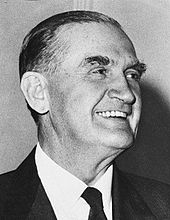 John McEwen succeeded Arthur Fadden as leader of the Country Party. He aslo served as Minister for Trade and Industry.
John McEwen succeeded Arthur Fadden as leader of the Country Party. He aslo served as Minister for Trade and Industry.
After winning office in 1949, Menzies fulfilled his promises to end rationing of butter, tea and petrol and provide a 5 shilling endowment for first born children, as well as for others.[14]
Australia experienced a prolonged economic boom during the Menzies years. Menzies remained a staunch supporter of links to the monarchy and British Commonwealth but formalised an alliance with the United States and launched post-war trade with Japan, beginning a growth of Australian exports of coal, iron ore and mineral resources that would steadily climb until Japan became Australia's largest trading partner.[15] John McEwen, as minister for commerce and for trade negotiated the Agreement on Commerce between Australia and Japan which was signed in July 1957. The agreement carried political risk for the Menzies government, because memories of atrocities perpetrated on Australians by Japan in World War II were still strong in the community. Britain meanwhile was negotiating entry into the European Economic Community in the early 1960s with major implications for Australian trade, which had previously enjoyed preferential treatment in the U.K. McEwen was active in maintaining tariff protections for agriculture, mining and manufacturing, which he believed would sustain employment and contribute to national defence.[16]
In the early 1950s, external affairs minister Percy Spender helped to establish the Colombo Plan for providing economic aid to underdeveloped nations in Australia's region. Under the scheme, many future Asian leaders studied in Australia.[17]
Other than blocking the nationalisation of the Banking system by the Labor Party, Menzies privatised the Commonwealth Oil Refinery. The wool industry remained a mainstay of the economy through the 1950s, indeed it was said that the Australian economy "rode on the sheep's back".[18]
While for most Australians the Menzies era was an era of propsperity, the nation experienced high inflation during the early years of Menzies' rule. The Korean War increased demand for commodities. Wool in particular boomed, leading to a rise in growers' incomes, but also to inflation. The Arbitration Court helped stabilize wages from 1953. From 1959-1960 Australia experienced something of a boom, spurred by overseas speculators and high domestic spending - resulting in recession by 1961, following a "horror" mini-budget designed to slow the economy. Unemployment reaching 2.1% (at that time considered "high") and Menzies went on to win the 1961 election by just one seat. Following the election, Menzies and Treasurer Harold Holt introduced another mini-budget designed to spur growth and the economy was in recovery.[19]
Cold War politics
 Cold War politics: Evdokia Petrova at Sydney Airport, being escorted to a waiting plane by two armed KGB agents during the Petrov Affair. Menzies intervened to prevent her forced removal to the USSR following the defection of her husband.
Cold War politics: Evdokia Petrova at Sydney Airport, being escorted to a waiting plane by two armed KGB agents during the Petrov Affair. Menzies intervened to prevent her forced removal to the USSR following the defection of her husband.
Menzies was firmly anti-Communist and committed troops to the Korean War and attempted to ban the Communist Party of Australia during the course of the war. In June 1950, Communist North Korea invaded South Korea. The Menzies government responded to a United States led United Nations Security Council request for military aid for South Korea and diverted forces from occupied Japan to begin Australia's involvement in the Korean War. The entry of Communist China into the war saw allied forces driven backwards down the peninsula. After fighting to a bitter standstill, the UN and North Korea signed a ceasefire agreement in July 1953. Australian forces had participated in such major battles as Kapyong and Maryang San. 17,000 Australians had served and casualties amounted to more than 1,500, of whom 339 were killed.[20]
Menzies introduced the Communist Party Dissolution Bill in 1950, which had popular support, but for many went too far in such measures as allowing the disqualifying of declared Communists from public offices, or industries considered vital to defence. The Bill had the support of anti-Communist Labor Senators, and so passed through Parliament. Early in 1951 however, the High Court declared the Act invalid for unconstitutionally interfering with civil liberties and property rights. Following the 1951 election, Menzies held a referendum seeking power for the Federal Parliament to legislate "With respect to Communists or Communism as the Parliament considers to be necessary or expedient for the defence or security of the Commonwealth". Labor leader H V Evatt campaigned against the proposal and the referendum was narrowly defeated.[21]
In 1951, during the early stages of the Cold War, Menzies spoke of the possibility of a looming third world war. Soviet diplomat Vladimir Petrov and his wife defected from the Soviet embassy in Canberra in 1954, revealing evidence of Russian spying activities and Menzies called a Royal Commission.[22] The Labor Party split over concerns about the influence of the Communist Party over the Trade Union movement, leading to the foundation of the breakaway Democratic Labor Party(DLP) whose preferences supported the Liberal and Country Party, in return for key concessions, like funding for Catholic schools. The new Party never won a Huse of Representatives seat, but often held the balance of power in the Senate.[23]
Treaties and defence
 Sir Percy Spender negotiated the ANZUS Treaty alliance with the United States and Colombo Plan for aid and development assistance for Asia.
Sir Percy Spender negotiated the ANZUS Treaty alliance with the United States and Colombo Plan for aid and development assistance for Asia.
With the memory of Japanese expansionism fresh in the Australian experience, and with the commencement of the Cold War seeing the Soviet Union dominating Eastern Europe, the Chinese Communist Party winning the Chinese Civil War in 1949 and Communist North Korea invading South Korea, Australia sought security outside its traditional allegiance to Britain. Analysts voiced fear of the "domino theory", according to which South East Asia would fall to Communism state by state. In defence policy, Menzies moved Australia to a policy of "forward defence" and committed troops against Communists insurgencies in South East Asia – the Malayan Emergency, and Indonesia's policy of Confrontation and, near the end of Menzies' prime ministership, the early stages of the Vietnam War.[22]
The Menzies Government entered the first formal military alliance outside of the British Commonwealth with the signing of the ANZUS Treaty between Australia, New Zealand and the United States in San Francisco in 1951. External Affairs Minister Percy Spender had put forward the proposal to work along similar lines to the NATO Alliance. The Treaty declared that any attack on one of the three parties in the Pacific area would be viewed as a threat to each, and that the common danger would be met in accordance with each nation's constitutional processes.
In 1954, the Menzies Government signed the South East Asia Collective Defence Treaty (SEATO) as a South East Asian counterpart to NATO.
Immigration and Aboriginal affairs
The Menzies Government instigated a series of important reforms to immigration laws, which resulted in the erosion of the restrictions of the unofficial White Australia Policy which had privileged British migrants over all others since the time of Australian Federation in 1901 and abolished restrictions on voting rights for Aborigines, which had persisted in some jurisdictions.
Beginning in 1949, Immigration Minister Harold Holt decided to allow 800 non-European war refugees to remain in Australia, and Japanese war brides to be admitted to Australia.[24] In 1950 External Affairs Minister Percy Spender instigated the Colombo Plan, under which students from Asian countries were admitted to study at Australian universities, then in 1957 non-Europeans with 15 years' residence in Australia were allowed to become citizens. In a watershed legal reform, a 1958 revision of the Migration Act introduced a simpler system for entry and abolished the "dictation test" which had permitted the exclusion of migrants on the basis of their ability to take down a dictation offered in any European language. Immigration Minister, Sir Alexander Downer, announced that 'distinguished and highly qualified Asians' might immigrate. Restrictions continued to be relaxed through the 1960s in the lead up to the Holt Government's watershed Migration Act, 1966.[25]
Campaigns for Aboriginal rights gathered pace in Australia during the Menzies era. When Menzies assumed office, Aborigines were still excluded from voting in Federal elections in Queensland and West Australia. In 1949, Parliament legislated to ensure that all Aboriginal ex-servicemen should have the right to vote. In 1961 a Parliamentary Committee was established to investigate and report to the Parliament on Aboriginal voting rights and in 1962, Menzies' Commonwealth Electoral Act provided that all Indigenous Australians should have the right to enrol and vote at federal elections.[26][27] Echoing developments in the United States and elsewhere in the Western World and their disintegrating colonial empires, attitudes to race underwent significant shifts in Australia during the Menzies era. Aboriginal artists like Albert Namatjira could gain great popularity and be presented to the Queen on her first Royal Tour, but under existing law still needed to be "granted" Australian citizenship. Indigenous activists like Douglas Nicholls and Faith Bandler continued their long campaign of lobbying governments for legal reform and University of Sydney students led by Charles N. Perkins sought to expose inequalities with their freedom rides in the mid-60s. Menzies' successor Harold Holt instigated the famous 1967 Referendum, which saw a 90% endorsement from the electorate to automatically include Aboriginal people in the national census.
Education and infrastructure
The Menzies Government extended Federal involvement in education and developed the city of Canberra as the national capital. Menzies introduced the Commonwealth scholarship scheme in 1951, to cover fees and pay a generous means-tested allowance for bright students from lower socioeconomic groups.[17] In 1956, a committee headed by Sir Keith Murray was established to inquire into the financial plight of Australia's universities, and Menzies' pumped funds into the sector under conditions which preserved the autonomy of universities. In 1960, money was set aside for the construction of the long-delayed Lake Burley Griffin – the original centre-piece of the design for Canberra.[22]
Menzies era
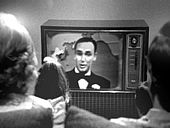 Bruce Gyngell re-enacts his introduction to the first regular television broadcast service to the residents of Sydney on TCN-9.
Bruce Gyngell re-enacts his introduction to the first regular television broadcast service to the residents of Sydney on TCN-9.
In his last address to the Liberal Party Federal Council in 1964, Menzies reflected on the "Liberal Creed" as follows:
“ As the etymology of our name ‘Liberal’ indicates, we have stood for freedom. We have realised that men and women are not just ciphers in a calculation, but are individual human beings whose individual welfare and development must be the main concern of government.... We have learned that the right answer is to set the individual free, to aim at equality of opportunity, to protect the individual against oppression, to create a society in which rights and duties are recognized and made effective." [28] ” Though often characterised as a "conservative" period in Australian history, the Menzies era was a period of sustained economic boom with rapid technological advance and Australia experienced the beginnings of sweeping social change – with the arrivals of rock and roll music and television in the 1950s. In 1956, Television in Australia began broadcasting. In a significant step, Menzies opted for a hybrid system, licensing both commercial and public broadcasters.[29] Melbourne hosted the Olympics and iconic Australian performers like Barry Humphries, Johnny O'Keefe and Slim Dusty emerged in the arts scene during the 1950s. Though support for the monarchy in Australia remained strong, Australia's cultural and political identity began a slow shift away from its traditional British allegiance.
Menzies was Knighted in 1963, and was honoured in 1965 by being appointed to succeed Winston Churchill as Constable of Dover Castle and Warden of the Cinque Ports.[30] Menzies' second period as prime minister lasted a record sixteen years and seven consecutive election victories and ended in his voluntary retirement on 26 January 1966, aged 71.[22] Harold Holt replaced the retiring Menzies in 1966 and the Holt Government went on to win 82 seats to Labor's 21 in the 1966 Election.[31]
See also
- History of Australia
- History of Australia since 1945
- Fourth Menzies Ministry
- Fifth Menzies Ministry
- Sixth Menzies Ministry
- Seventh Menzies Ministry
- Eighth Menzies Ministry
- Ninth Menzies Ministry
- Tenth Menzies Ministry
References
- ^ http://primeministers.naa.gov.au/primeministers/lyons/before-office.aspx
- ^ http://primeministers.naa.gov.au/primeministers/scullin/in-office.aspx
- ^ Brian Carroll; From Barton to Fraser; Cassell Australia; 1978
- ^ "Formation of the Liberal Party of Australia". Party History. Liberal Party of Australia – Queensland Division. Archived from the original on 26 April 2007. http://web.archive.org/web/20070426002837/http://www.qld.liberal.org.au/history/formation.aspx. Retrieved 11 April 2007.
- ^ a b Ian Hancock. "The Origins of the Modern Liberal Party". Harold White Fellowships. National Library of Australia. http://www.nla.gov.au/grants/haroldwhite/papers/ihancock.html. Retrieved 11 April 2007.
- ^ http://www.adb.online.anu.edu.au/biogs/A150416b.htm?hilite=menzies
- ^ http://dl.nfsa.gov.au/module/1750/
- ^ http://www.liberals.net/theforgottenpeople.htm
- ^ http://www.liberal.org.au/The-Party/Our-History.aspx
- ^ Brian Carroll; From Barton to Fraser; Cassell Australia; 1978
- ^ Brian Carroll; From Barton to Fraser; Cassell Australia; 1978
- ^ http://primeministers.naa.gov.au/primeministers/menzies/elections.aspx
- ^ http://www.adb.online.anu.edu.au/biogs/A140134b.htm
- ^ Brian Carroll; From Barton to Fraser; Cassell Australia; 1978
- ^ http://primeministers.naa.gov.au/primeministers/menzies/in-office.aspx
- ^ http://www.adb.online.anu.edu.au/biogs/A150245b.htm?hilite=john%3Bgorton
- ^ a b http://www.smh.com.au/opinion/politics/the-way-we-were-quiet-maybe-but-certainly-not-dull-20110425-1du0l.html
- ^ http://dl.nfsa.gov.au/module/1592/
- ^ Brian Carroll; From Barton to Fraser; Cassell Australia; 1978
- ^ http://www.awm.gov.au/atwar/korea.asp
- ^ Brian Carroll; From Barton to Fraser; Cassell Australia; 1978
- ^ a b c d http://www.adb.online.anu.edu.au/biogs/A150416b.htm?hilite=robert%3Bmenzies
- ^ http://www.abc.net.au/news/stories/2010/04/30/2886680.htm?site=thedrum
- ^ http://www.immi.gov.au/media/fact-sheets/08abolition.htm
- ^ http://www.immi.gov.au/media/fact-sheets/08abolition.htm
- ^ http://aec.gov.au/Voting/indigenous_vote/indigenous.htm
- ^ http://aec.gov.au/Voting/indigenous_vote/history.htm
- ^ http://www.theaustralian.com.au/news/opinion/we-believe-the-liberal-party-and-the-liberal-cause/story-e6frg6zo-1225791120808
- ^ http://wwwmcc.murdoch.edu.au/ReadingRoom/4.2/Curthoys.html
- ^ http://primeministers.naa.gov.au/primeministers/menzies/index.aspx
- ^ http://primeministers.naa.gov.au/primeministers/holt/elections.aspx
Governments of Australia Lyons Government • Fadden Government • Menzies Government I • Curtin Government • Chifley Government • Menzies Government II • Holt Government • Gorton Government • Whitlam Government • Fraser Government • Hawke-Keating Government • Howard Government • Rudd Government • Gillard GovernmentCategories:- Governments of Australia
- Liberal Party of Australia
- History of Australia since 1945
Wikimedia Foundation. 2010.

